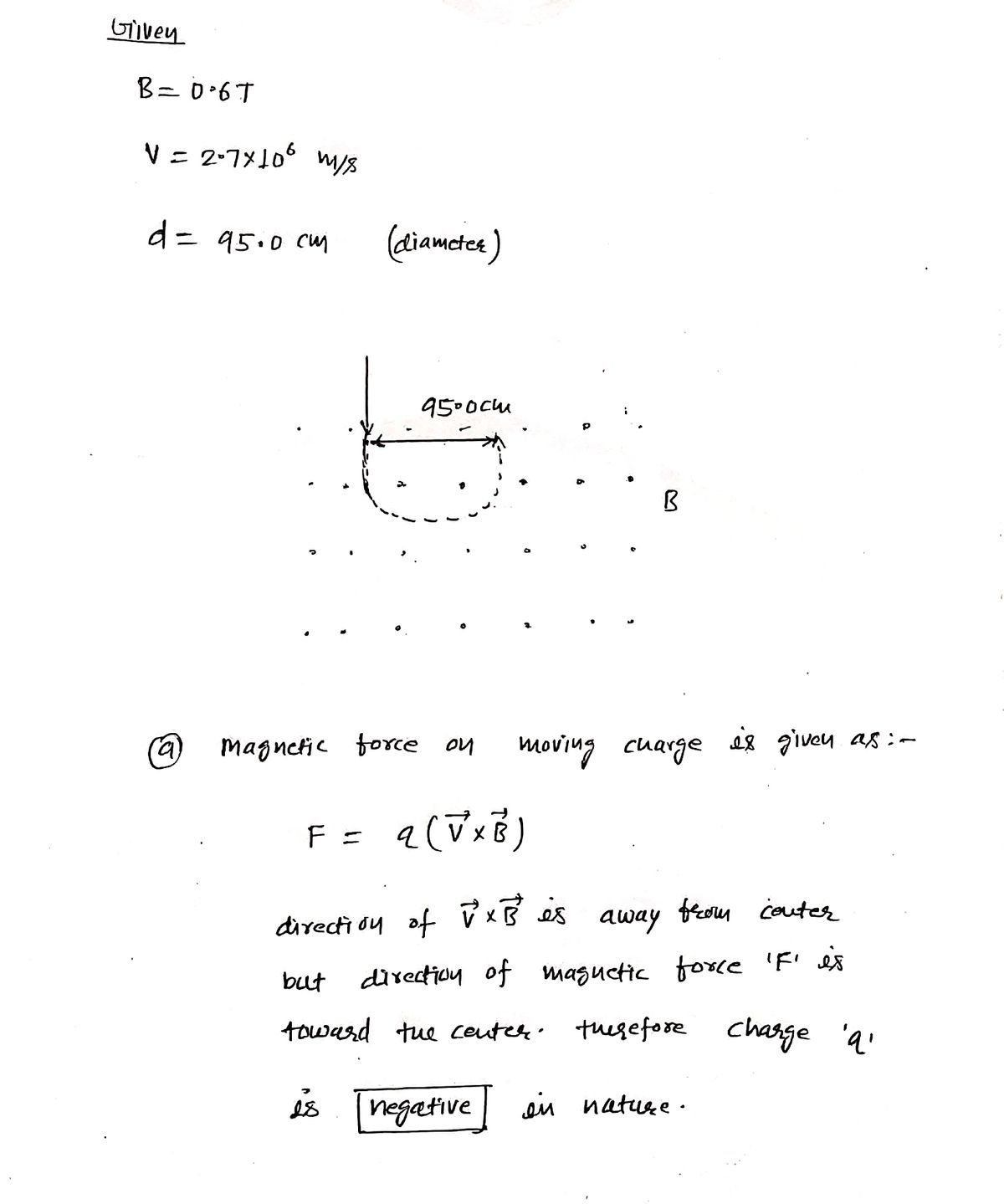1. In the diagram below, a charged particle enters a region of uniform magnètic field where B = 0.6 T. The particle has an initial speed of 2.7 x 106 m/s. Keep in mind Newton's Second Law and recall the equation for centripetal acceleration: 2/r. a. Ignore gravity and first determine the sign of the charged particle if it follows the trajectory of the dashed semicircle. b. Next, use the information given to derive an equation for the charge-to-mass ratio (q/m) of the particle in terms of the particle's speed, the magnitude of the magnetic field and the radius of the semicircle. c. Lastly, calculate the charge to mass ratio of this particle. 95.0 cm B
1. In the diagram below, a charged particle enters a region of uniform magnètic field where B = 0.6 T. The particle has an initial speed of 2.7 x 106 m/s. Keep in mind Newton's Second Law and recall the equation for centripetal acceleration: 2/r. a. Ignore gravity and first determine the sign of the charged particle if it follows the trajectory of the dashed semicircle. b. Next, use the information given to derive an equation for the charge-to-mass ratio (q/m) of the particle in terms of the particle's speed, the magnitude of the magnetic field and the radius of the semicircle. c. Lastly, calculate the charge to mass ratio of this particle. 95.0 cm B
College Physics
11th Edition
ISBN:9781305952300
Author:Raymond A. Serway, Chris Vuille
Publisher:Raymond A. Serway, Chris Vuille
Chapter1: Units, Trigonometry. And Vectors
Section: Chapter Questions
Problem 1CQ: Estimate the order of magnitude of the length, in meters, of each of the following; (a) a mouse, (b)...
Related questions
Question

Transcribed Image Text:1. In the diagram below, a charged particle enters a region of uniform magnètic field where B
0.6 T. The particle has an initial speed of 2.7 x 106 m/s. Keep in mind Newton's Second
Law and recall the equation for centripetal acceleration: 1²/r.
a. Ignore gravity and first determine the sign of the charged particle if it follows the
trajectory of the dashed semicircle.
b.
Next, use the information given to derive an equation for the charge-to-mass ratio (q/m)
of the particle in terms of the particle's speed, the magnitude of the magnetic field and
the radius of the semicircle.
c. Lastly, calculate the charge to mass ratio of this particle.
95.0 cm
B
Expert Solution
Step 1

Trending now
This is a popular solution!
Step by step
Solved in 2 steps with 2 images

Knowledge Booster
Learn more about
Need a deep-dive on the concept behind this application? Look no further. Learn more about this topic, physics and related others by exploring similar questions and additional content below.Recommended textbooks for you

College Physics
Physics
ISBN:
9781305952300
Author:
Raymond A. Serway, Chris Vuille
Publisher:
Cengage Learning

University Physics (14th Edition)
Physics
ISBN:
9780133969290
Author:
Hugh D. Young, Roger A. Freedman
Publisher:
PEARSON

Introduction To Quantum Mechanics
Physics
ISBN:
9781107189638
Author:
Griffiths, David J., Schroeter, Darrell F.
Publisher:
Cambridge University Press

College Physics
Physics
ISBN:
9781305952300
Author:
Raymond A. Serway, Chris Vuille
Publisher:
Cengage Learning

University Physics (14th Edition)
Physics
ISBN:
9780133969290
Author:
Hugh D. Young, Roger A. Freedman
Publisher:
PEARSON

Introduction To Quantum Mechanics
Physics
ISBN:
9781107189638
Author:
Griffiths, David J., Schroeter, Darrell F.
Publisher:
Cambridge University Press

Physics for Scientists and Engineers
Physics
ISBN:
9781337553278
Author:
Raymond A. Serway, John W. Jewett
Publisher:
Cengage Learning

Lecture- Tutorials for Introductory Astronomy
Physics
ISBN:
9780321820464
Author:
Edward E. Prather, Tim P. Slater, Jeff P. Adams, Gina Brissenden
Publisher:
Addison-Wesley

College Physics: A Strategic Approach (4th Editio…
Physics
ISBN:
9780134609034
Author:
Randall D. Knight (Professor Emeritus), Brian Jones, Stuart Field
Publisher:
PEARSON